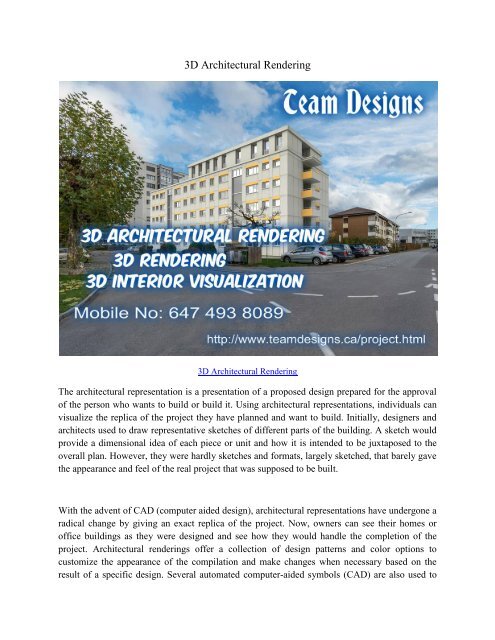3D Architectural Rendering
Create successful ePaper yourself
Turn your PDF publications into a flip-book with our unique Google optimized e-Paper software.
<strong>3D</strong> <strong>Architectural</strong> <strong>Rendering</strong><br />
<strong>3D</strong> <strong>Architectural</strong> <strong>Rendering</strong><br />
The architectural representation is a presentation of a proposed design prepared for the approval<br />
of the person who wants to build or build it. Using architectural representations, individuals can<br />
visualize the replica of the project they have planned and want to build. Initially, designers and<br />
architects used to draw representative sketches of different parts of the building. A sketch would<br />
provide a dimensional idea of each piece or unit and how it is intended to be juxtaposed to the<br />
overall plan. However, they were hardly sketches and formats, largely sketched, that barely gave<br />
the appearance and feel of the real project that was supposed to be built.<br />
With the advent of CAD (computer aided design), architectural representations have undergone a<br />
radical change by giving an exact replica of the project. Now, owners can see their homes or<br />
office buildings as they were designed and see how they would handle the completion of the<br />
project. <strong>Architectural</strong> renderings offer a collection of design patterns and color options to<br />
customize the appearance of the compilation and make changes when necessary based on the<br />
result of a specific design. Several automated computer-aided symbols (CAD) are also used to
distinguish different units and segments of buildings, making it easier for the visitor to identify<br />
each unit and its use. The latest technologies also provide the available options according to the<br />
chosen budget and provided when looking for electronic design formats.<br />
<strong>3D</strong> <strong>Architectural</strong> <strong>Rendering</strong> interpretation implies the basic conceptualization of a proposed<br />
project, which forms the basis of any construction. The various elements used in architectural<br />
representations, such as color, design patterns, symbols and animations, play a key role in the<br />
visualization of the replica and, ultimately, in the construction of the real building. All the<br />
subtleties required for an improved design are included in the architectural representations,<br />
which are the real construction follow-ups. Representation techniques have evolved throughout<br />
the period, realistically giving shape to planned projects.












